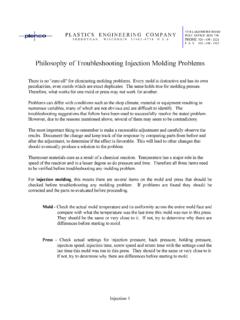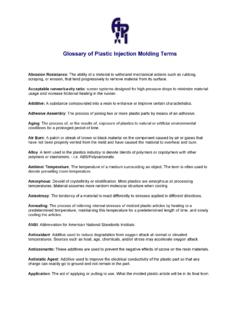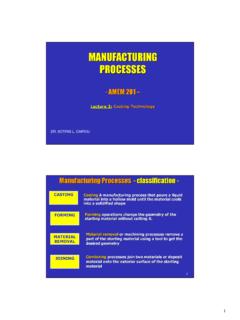Transcription of Sect 29 Preventive Maintenance - Plenco
1 Page 1 of 6 PLASTICS ENGINEERING COMPANY SHEBOYGAN, WISCONSIN 53082-0758 3518 LAKESHORE ROAD POST OFFICE BOX 758 PHONE 920 - 458 - 2121 F A X 920 - 458 - 1923 Preventive Maintenance In order to maintain the highest level of productivity and quality, Preventive Maintenance of presses and tooling is required. The following tips are presented as aids to help you achieve that goal. Presses The Preventive Maintenance required for any molding press is found in the press manufacturer s Maintenance manual. Molds Ejector and Guide Pin Lubrication When a mold is heated to the temperatures necessary to process thermosetting materials, it is important to lubricate the moving or sliding parts of the mold to prevent seizing or galling.
2 The lubricant used, should be suitable for high temperature applications. Items that will need lubricating include the guide pins for the mold, the ejector pins, the guide pins for the ejector system and the wear areas of any side core slides. Final Mold Inspection After each run, the mold should be taken to the toolroom and a complete inspection conducted. Items that frequently need to be replaced or repaired are: * Broken ejector pins * Worn gates and vents * Damaged cores or cavities * Chipped or damaged parting lines * Worn or damaged sprue bushings * Broken return springs Page 2 of 6 The following items should be checked and corrected as needed: * Flash behind the moving slides * Condition of the plating * Staining in the cavities, cores or vents This is also a good time to do general mold Maintenance such as.
3 * Clean and lubricate the ejector pins and rack * Clean the flash off of the mold and all side cores * Make note of the general condition of the tool Landing Blocks Landing blocks are blocks of steel that are mounted on the mold to hold the mold halves at the proper height when the mold is closed. They divert the clamping force of the press away from the parting line in order to lessen the likelihood of crushing the mold or damaging the parting line. The size of the landing blocks is determined from the tonnage of the press being used, per the following formulation: The total projected area of the landing blocks should be equal to the MAXIMUM clamping force of the press divided by five Example: If the maximum clamping force of the press equals 100 tons the total projected area of the landing blocks would be 20 in (12,904 mm2) 100 tons 5 = 20 in (12,904 mm2) The size and location of each landing block is up to the discretion of the molder and the mold maker.
4 However, the blocks should be evenly divided around the parting line so the mold closes uniformly. Mold Cleaning When molding thermoset materials, it is very important to keep the mold surfaces around the parting line clean. Flash or any materials that may stick in these areas can damage to the mold. Therefore, all flash or foreign materials should be blown off or physically removed before molding the next shot. If blowing or scraping does not completely remove the stuck material, then it may require the mold cleaning procedure outlined below. This procedure provides a general guide to cleaning any residue on the mold surfaces, which are the vents, gates and other parting line areas surrounding the cavities, but not the cavities.
5 Only an experienced Tool Maker should clean the cavity surfaces. Page 3 of 6 Mold Cleaning Procedure 1.) This procedure works best when the mold is at room temperature. This helps avoid burns to employees while doing the cleaning and reduces evaporation of the penetrating oil and buffing compound. 2.) Carefully blow off the mold surface. Wipe with a clean soft cloth, starting at the outside edge of the mold cavities and working outward. 3.) Using a brass scraper, remove any larger particles by gently scraping on the mold surface. NOTE: Be careful using brass tools since they can become work hardened and become harder than steel.
6 4.) Use # 00 or finer steel wool and penetrating oil to clean the mold surface, being careful not to enter the cavity in order to prevent scratching it. Clean in the direction of the material s flow through the mold, rubbing as directed in diagram #1. This should remove the majority of the residue. Carefully blow off the mold surface to prevent scratching, and wipe with a clean soft cloth. 5.) If there is still some staining or difficult to remove residue, a Balsam wood stick (soft or medium hardness) may be used. Make a paste using penetrating oil and buffing compound. Rub the Balsam wood stick in this paste and then rub the mold surface with it, being careful not to enter the cavity, in order to prevent scratching it.
7 See diagram #1 for proper direction to rub. Carefully blow off the mold surface to prevent scratching and wipe with a clean soft cloth. 6.) A felt bob (soft or medium hardness) may be used in place of or after the Balsam wood stick. Make a paste using penetrating oil and buffing compound. Rub the Balsam wood stick in this paste and then rub the mold surface with it, being careful not to enter the cavity, in order to prevent scratching it. See diagram #1 for proper direction to rub. Carefully blow off the mold surface to prevent scratching and wipe with a clean soft cloth. 7.) After all cleaning is completed, carefully blow off the mold surface to prevent scratching and wipe with a clean soft cloth.
8 The mold must be waxed and broke in before production parts are molded. Gate Cavity Vent Proper direction to clean the mold surface Page 4 of 6 Wear Resistant Design Tips for Thermoset Molds Molds used in the processing of thermoset materials are subject to wear due to the abrasiveness of the fillers used in the material. A number of approaches have been used to slow down the wearing away of the mold components. Mold Steels In high wear areas of the mold, the mold components can be machined from steel that is more wear resistant than standard mold steels like H-13 or S-7.
9 Common steels used for this purpose are M3, D2 and Ferro tic. Because they are a hard steel grades and are more susceptible to cracking or breakage, they are typically only used in high wear areas. Protective Coatings Many mold coatings have been developed to protect the mold by reducing its rate of wear. Chrome - A thin layer of chrome is applied to the entire molding surface. This layer can be as thin as mm ( ") or it can be as thick as mm ( "). This not only protects the mold, but it aids in the release of the molded parts. The thicker layers of chrome are sometimes used to help correct an out of tolerance dimension.
10 Electroless Nickel - This material is frequently used in molds processing thermoplastic materials, but in molds for processing thermoset materials it has some shortcomings. Nickel is soft and therefore tends to wear away rather quickly. It also does not have the same release properties as chrome, so the parts will not release from the tool as readily as if it were chrome plated. Additionally, some thermoset materials have fillers that will chemically react with nickel. Nitriting - A nitrited surface is very hard and as a result it is more wear resistant than untreated steel. However, nitriting does not improve mold release properties of the tool.










